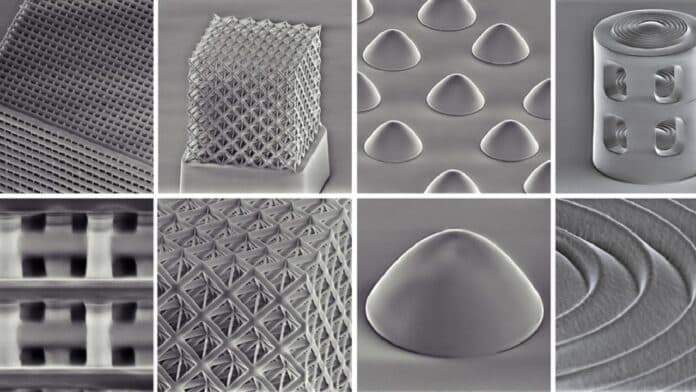Printing glass using additive manufacturing processes could provide new materials and structures for various applications.
The Karlsruhe Institute of Technology (KIT) has developed a new technology for printing nanometer-scale quartz glass structures directly onto semiconductor chips utilizing a hybrid organic-inorganic polymer resin as feedstock.
Printing micro- and nanometer-scaled quartz glass structures from pure silicon dioxide bring up many new opportunities in optics, photonics, and semiconductor technologies. So far, procedures have relied on traditional sintering. Temperatures for sintering silicon dioxide nanoparticles exceed 1100°C, making direct deposition onto semiconducting chips impossible.
This technique does not require sintering, resulting in substantially lower temperatures and higher resolution, allowing visible-light nanophotonics. Dr. Jens Bauer of KIT’s Institute of Nanotechnology (INT) created a new method for producing clear quartz glass with excellent resolution and outstanding mechanical qualities at much lower temperatures.
A hybrid organic-inorganic polymer resin is used in the process, which is made up of polyhedral oligomeric silsesquioxane (POSS) molecules, which are tiny cage-like silicon dioxide molecules with organic functional groups.
After 3D printing the material to produce a 3D nanostructure, it is heated in air to 650°C to eliminate the organic components. The inorganic POSS cages combine to generate a continuous quartz glass microstructure or nanostructure at a temperature that is only half that required for techniques based on nanoparticle sintering.
Bauer explains, “The lower temperature enables the free-form printing of robust, optical-grade glass structures with the resolution needed for visible-light nanophotonics, directly on semiconductor chips; apart from an excellent optical quality, the quartz glass produced has excellent mechanical properties and can be processed easily.
The reduced temperature enables free-form printing of strong, optical-grade glass structures with the resolution required for visible-light nanophotonics directly on semiconductor chips. The quartz glass created has good mechanical qualities and is simple to prepare.
The researchers utilized the POSS resin to print photonic crystals with free-standing, 97 nm wide beams, parabolic microlenses, and a multi-lens micro objective with nanostructured elements. Structures produced by the method are stable even under extreme chemical or thermal conditions.
Professor Oliver Kraft, Vice President of Research at KIT, said, “The INT group headed by Jens Bauer is associated with the 3DMM2O Cluster of Excellence.”
The research results, recently published in Science, are just one example of how the cluster successfully supports early-stage researchers.3DMM2O, or 3D Matter Made to Order, is a collaborative Cluster of Excellence of KIT and Heidelberg University.
By merging natural sciences and engineering, it takes a very interdisciplinary approach. Its goal is to take 3D additive manufacturing to the next level, from molecular to macroscopic dimensions.
Journal Reference:
- J. Bauber, C. Crook, et al. A centerless, low-temperature route to 3D print nanoscale optical-grade glass. Science. DOI: 10.1126/science.abq3037
